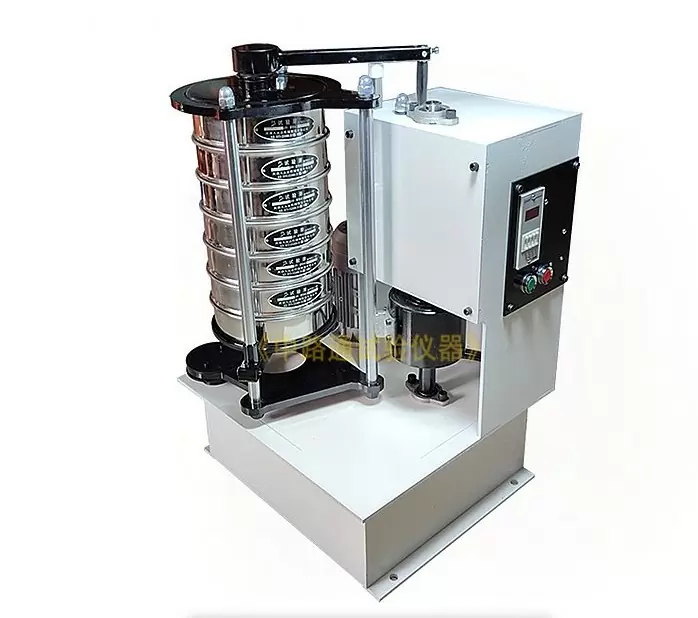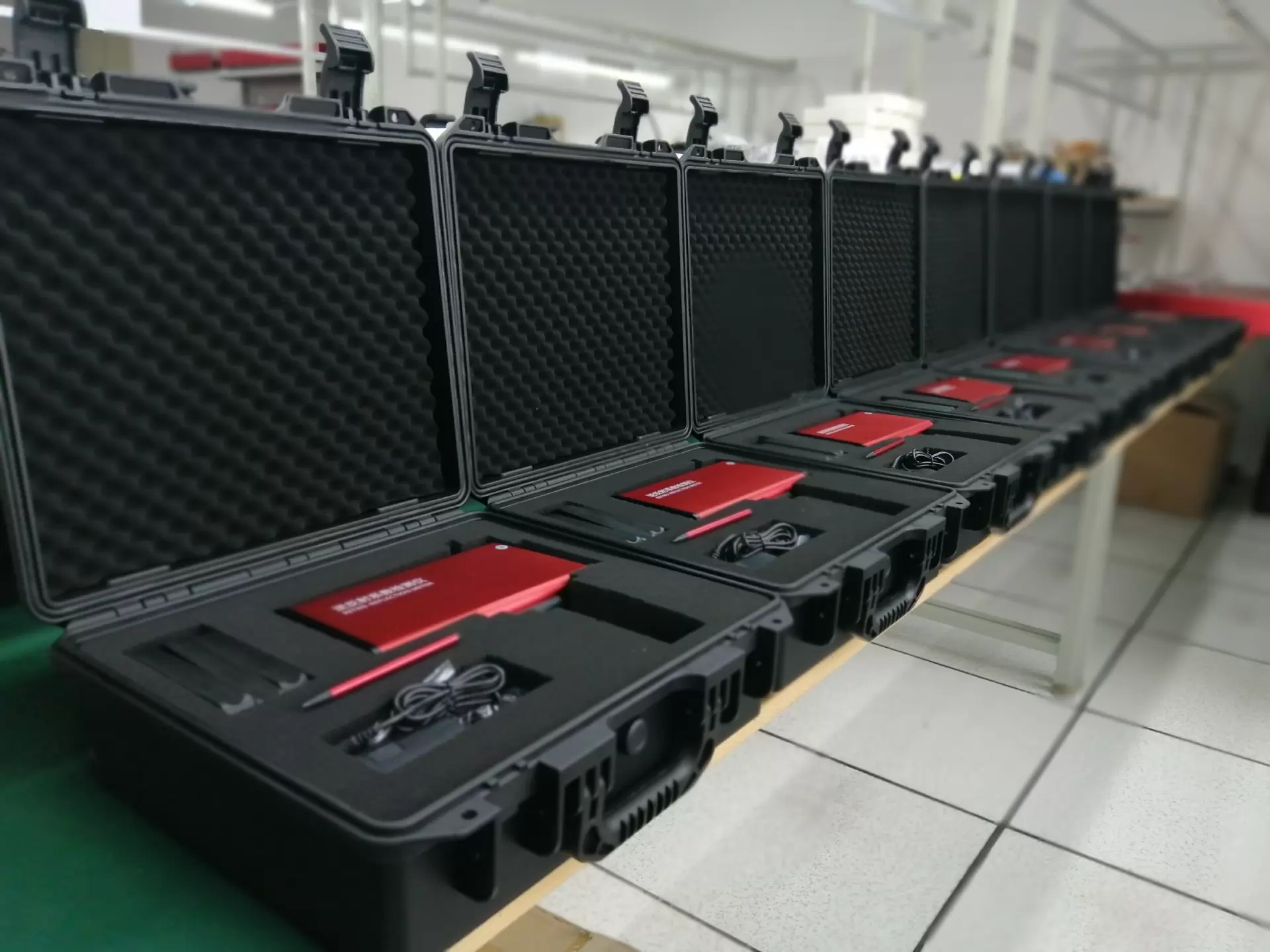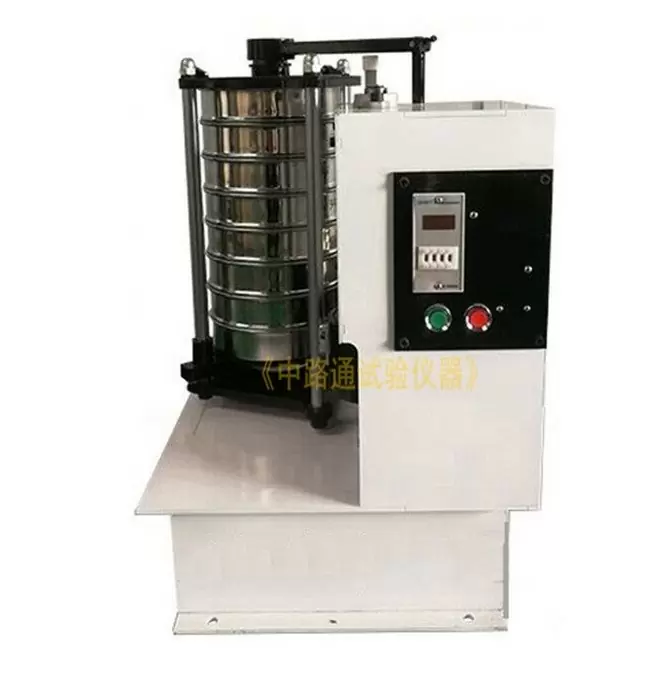PRODUCTS

Road glass bead vibrating screen
Road glass bead vibrating screen is used to determine the particle size distribution of glass beads. The vibrating screen is mainly composed of a base, a sieve and a transmission mechanism. The vibrating screen can be equipped with special fixtures, which can clamp Φ200 test sieve, and can also install Φ75, Φ100 sets of sieves. The clamping is convenient and flexible, the clamping is firm, and it can automatically stop. Standard test sieve 850μm, 600μm, 300μm, 212tμm, 150μm, 106μm, 90μm, (7 pieces) set
Conforms to: The People's Republic of China Transportation Industry Standard: Glass Beads for Road Marking JT/T 446-2001
GB/T 6582—1997 Particle test method and classification of water resistance of glass at 98℃
Instrument use
Road glass bead vibrating screen is used to determine the particle size distribution of glass beads. The vibrating screen is mainly composed of a base, a sieve and a transmission mechanism. The vibrating screen can be equipped with special fixtures, which can clamp Φ200 test sieve, and can also install Φ75, Φ100 sets of sieves. The clamping is convenient and flexible, the clamping is firm, and it can automatically stop. Standard test sieve 850μm, 600μm, 300μm, 212tμm, 150μm, 106μm, 90μm, (7 pieces) set
Conforms to: The People's Republic of China Transportation Industry Standard: Glass Beads for Road Marking JT/T 446-2001
GB/T 6582—1997 Particle test method and classification of water resistance of glass at 98℃
Technical features:
1. The product is more durable, light and convenient
2. The maintenance is simpler, and the accessories are easy to repair and easy
3. The screening efficiency is high, and it has both reciprocating and top hitting vibrations at the same time
4. Will not block the screen surface, cut the material quickly, and screen thoroughly
5. The product is more durable, light and convenient
6. The maintenance is simpler, and the accessories are easy to repair and easy to buy
7. The screening efficiency is high, and it has both reciprocating and top hitting vibrations.
8. Will not block the screen surface, cut the material quickly, and screen thoroughly
Three, technical parameters:
1. Diameter of sieve: φ200mm
2. Number of layers of sieve: 8 layers
3. Number of rotations: 290±6 /min
4. Number of taps: 156±3 times
5. Slap height: 38±8mm
6. Chassis levelness: ≤0.6mm/min
7. Rotation stroke: 25mm
8. Motor power: 0.37kw
9. Working voltage: 220V
10. Dimensions: 540X400X720mm
11. Whole machine weight: 76Kg
working principle:
The motor drives the gear to the main shaft through the timing belt. After the gear is changed, the main shaft rotates at the required speed. The main shaft drives the eccentric wheel to make the slide plate reciprocate, and drives the test screen installed in the slide plate tray to shake left and right, and the main shaft drives the ejector pin gear. Rotation, after the speed change, the ejector pin gear hits the ejector rod through the cam, the ejector rod makes the hammer hit the test sieve top cover up and down, making the materials in the test sieve and the sample sieve reciprocate and vibrate up and down, making the screen mesh smaller than the test sieve The material particles with holes are sieved into the lower test sieve, which is screened layer by layer so that only materials of the same particle size are left in each layer of the test sieve. To achieve the separation of different particle sizes and determine the particle size composition of this material.
Features:
1) Accurate transmission and good consistency: Due to the use of gears to drive the synchronous belt transmission, the speed ratio is accurate, and the speed drop phenomenon of the general V-belt will not occur (the triangle belt has a 3% drop rate), so that every time the screen is under the same time The sub-motion is consistent (the gear transmission ratio accuracy rate is 99.99%). At the same time, the equipment is equipped with a digital timer, which will automatically stop when the time is set to ensure the consistency of inspection or production.
2) Long service life, low maintenance and maintenance costs: Since the two gears are not in direct contact, they will not wear out. The timing belt and gear have good contact adaptability and long life. Only the timing belt needs to be replaced during maintenance. At the same time, the eccentric wheel set adopts an integrated method. Re-installation is accurate and convenient. The rotating part adopts bearings (standard parts), which is not easy to wear, low cost and easy to replace. Reduce the technical requirements and cost of maintenance.
3) The screening efficiency is high. This screening method enables both reciprocating and flapping vibrations during screening, without clogging the screen, cutting materials quickly, and screening thoroughly.
4) Cleanliness: Because this transmission method does not need to be refueled, it reduces maintenance costs and protects the environment, which is very beneficial for the production environment to be clean.
Use industry use analysis:
It is widely used in the inspection of solid, powder, slurry and other materials in scientific research units, laboratories, inspection rooms, production control, etc. in food, medicine, chemicals, abrasives, pigments, mining, metallurgy, geology, ceramics, national defense and other industries. Screening, classification, particle size analysis, debris content analysis, etc. Especially for the production and screening of superhard materials such as diamond.
Instructions:
Note 1. The direction of rotation of the motor must be in the direction indicated by the arrow (three-phase motor) (due to the use of a cam to hit the ejector rod, the direction will be stuck and cannot be rotated).
Check the motor rotation direction method: lift up the rod before starting the machine, and then start the machine. At this time, check the rotation direction of the motor. Make sure the direction is correct before using it normally.
The direction of the 220V single-phase motor has been adjusted before leaving the factory.
2. The equipment must be fixed before operation. The fixing is fixed by foot bolts, and expansion screws can be used to fix the equipment on the concrete floor.
3. Install the test sieve. Customers can add 1-7 layers of test screens according to their needs. The specific method is: loosen the tray fastening screws, move the tray downwards, load the test sieves (sample screens, standard sieves) filled with materials, then lift the tray to a suitable position, tighten the fastening screws, and cover the flip cover , After putting down the hammer, set a good time to boot. The fixture with a diameter of 100mm and a diameter of 75mm can be used with corresponding size sets of screens, and special sizes such as 300mm diameter screens can be customized.
4. The equipment is equipped with timing equipment, the user can adjust the time of use, and it will automatically stop when it is turned on. The first two digits of the adjustment time are minutes, and the last two digits are seconds. Users can adjust the running time according to their needs.
5. The slap height of the equipment can be adjusted before leaving the factory. If necessary, the user can loosen the fastening nut, adjust the top rod head thread to rise or lower to a suitable position, and then prepare the nut.
6. The upper and lower slides, fuel nozzles, etc. should be refueled regularly.
7. Check and refuel regularly every month.
8. For the first installation, please lay the foot screws.
Remember! The time cannot be adjusted when the power is on, adjust it after stopping.





